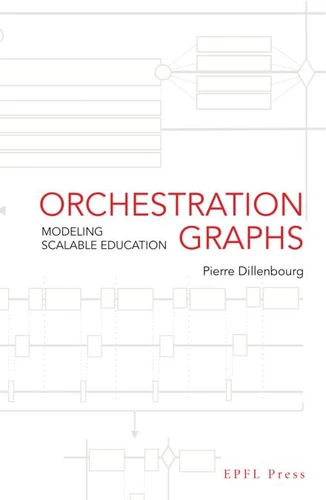Orchestration Graphs. Modeling Scalable Education
Par :Formats :
Disponible dans votre compte client Decitre ou Furet du Nord dès validation de votre commande. Le format Multi-format est :
- Pour les liseuses autres que Vivlio, vous devez utiliser le logiciel Adobe Digital Edition. Non compatible avec la lecture sur les liseuses Kindle, Remarkable et Sony
 , qui est-ce ?
, qui est-ce ?Notre partenaire de plateforme de lecture numérique où vous retrouverez l'ensemble de vos ebooks gratuitement
Pour en savoir plus sur nos ebooks, consultez notre aide en ligne ici
- Nombre de pages212
- FormatMulti-format
- ISBN978-2-88914-378-8
- EAN9782889143788
- Date de parution16/06/2015
- Protection num.pas de protection
- Infos supplémentairesMulti-Format
- ÉditeurPresses Polytechniques et Univer...
Résumé
THIS BOOK IS AVAILABLE ON AMAZON / By modeling pedagogical scenarios as directed geometrical graphs and proposing an associated modeling language, this book describes how rich learning activities, often designed for small classes, can be scaled up for use with thousands of participants. With the vertices of these graphs representing learning activities and the edges capturing the pedagogical relationship between activities, individual, team, and class-wide activities are integrated into a consistent whole.
The workflow mechanisms modeled in the graphs enable the construction of scenarios that are richer than those currently implemented in MOOCs. The cognitive states of learners in two consecutive activities feed a transition matrix, which encapsulates the probability of succeeding in the second activity, based on success in the former. This transition matrix is summarized by a numerical value, which is used as the weight of the edge.
This pedagogical framework is connected to stochastic models, with the goal of making learning analytics more appealing for data scientists. However, the proposed modeling language is not only useful in learning technologies, it also allows researchers in learning sciences to formally describe the structure of any lesson, from an elementary school lesson with 20 students to an online course with 20, 000 participants.
The workflow mechanisms modeled in the graphs enable the construction of scenarios that are richer than those currently implemented in MOOCs. The cognitive states of learners in two consecutive activities feed a transition matrix, which encapsulates the probability of succeeding in the second activity, based on success in the former. This transition matrix is summarized by a numerical value, which is used as the weight of the edge.
This pedagogical framework is connected to stochastic models, with the goal of making learning analytics more appealing for data scientists. However, the proposed modeling language is not only useful in learning technologies, it also allows researchers in learning sciences to formally describe the structure of any lesson, from an elementary school lesson with 20 students to an online course with 20, 000 participants.
THIS BOOK IS AVAILABLE ON AMAZON / By modeling pedagogical scenarios as directed geometrical graphs and proposing an associated modeling language, this book describes how rich learning activities, often designed for small classes, can be scaled up for use with thousands of participants. With the vertices of these graphs representing learning activities and the edges capturing the pedagogical relationship between activities, individual, team, and class-wide activities are integrated into a consistent whole.
The workflow mechanisms modeled in the graphs enable the construction of scenarios that are richer than those currently implemented in MOOCs. The cognitive states of learners in two consecutive activities feed a transition matrix, which encapsulates the probability of succeeding in the second activity, based on success in the former. This transition matrix is summarized by a numerical value, which is used as the weight of the edge.
This pedagogical framework is connected to stochastic models, with the goal of making learning analytics more appealing for data scientists. However, the proposed modeling language is not only useful in learning technologies, it also allows researchers in learning sciences to formally describe the structure of any lesson, from an elementary school lesson with 20 students to an online course with 20, 000 participants.
The workflow mechanisms modeled in the graphs enable the construction of scenarios that are richer than those currently implemented in MOOCs. The cognitive states of learners in two consecutive activities feed a transition matrix, which encapsulates the probability of succeeding in the second activity, based on success in the former. This transition matrix is summarized by a numerical value, which is used as the weight of the edge.
This pedagogical framework is connected to stochastic models, with the goal of making learning analytics more appealing for data scientists. However, the proposed modeling language is not only useful in learning technologies, it also allows researchers in learning sciences to formally describe the structure of any lesson, from an elementary school lesson with 20 students to an online course with 20, 000 participants.





